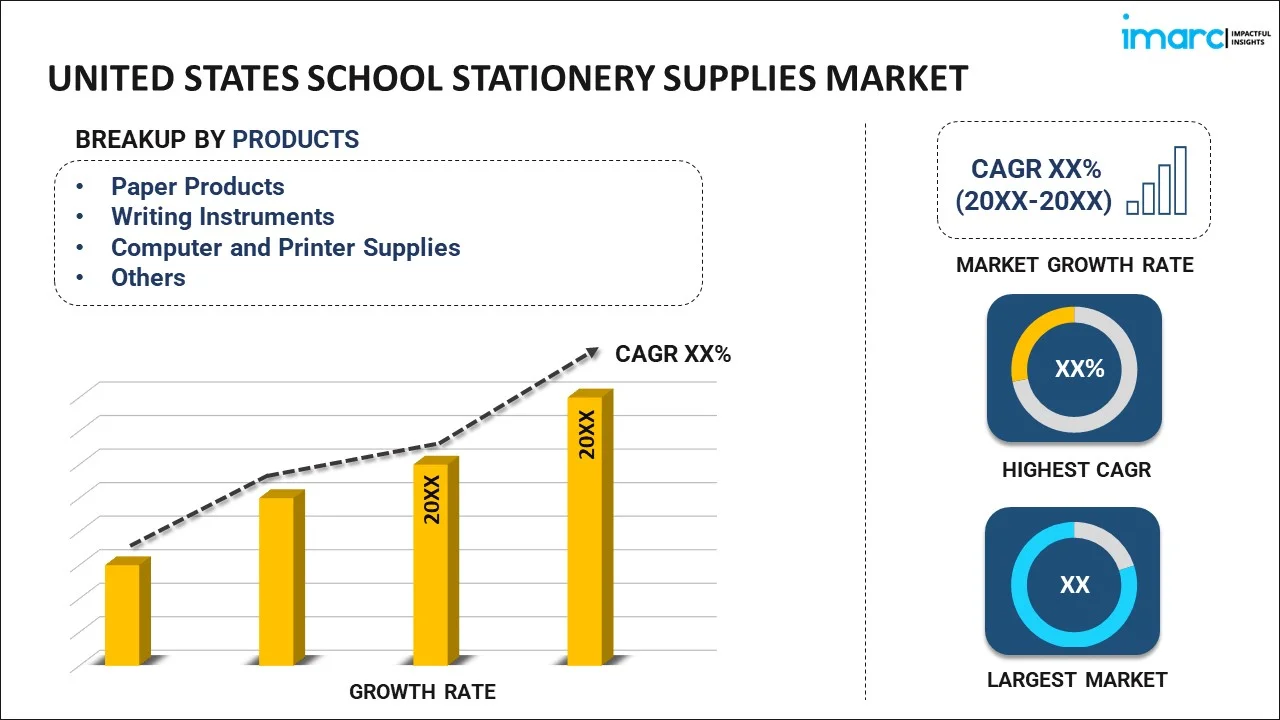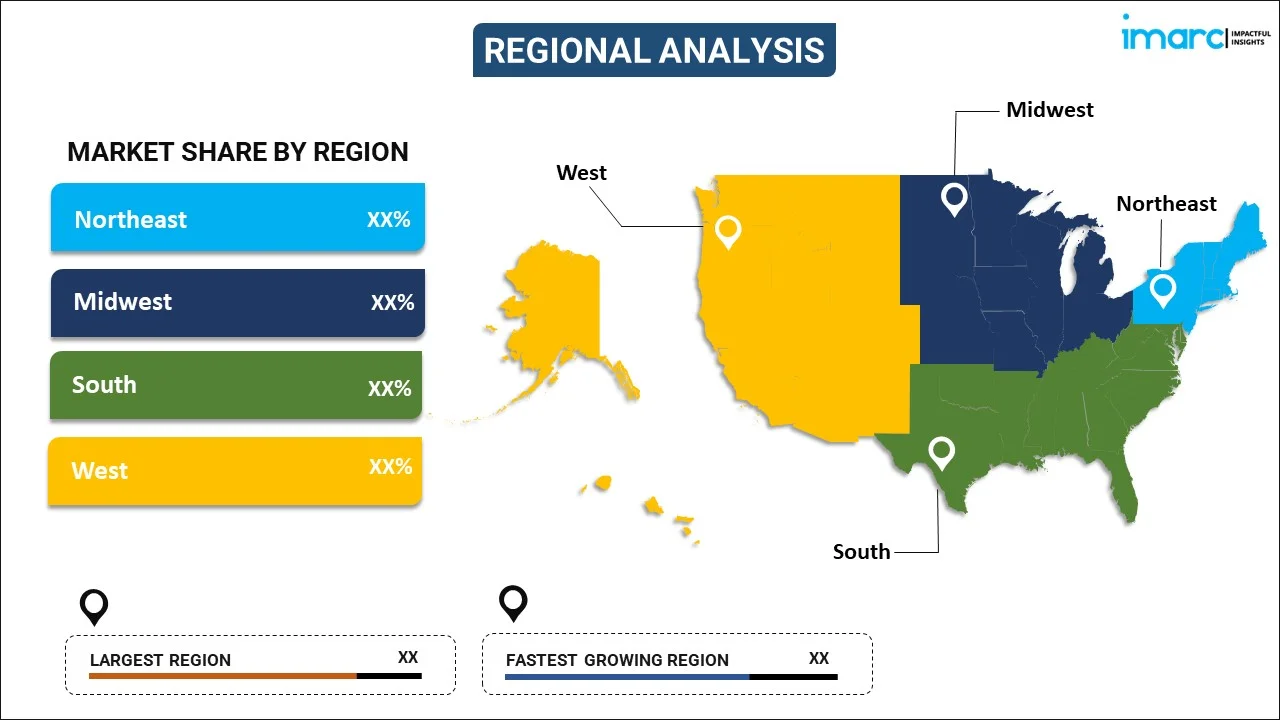
United States School Stationery Supplies Market Report by Product (Paper Products, Writing Instruments, Computer and Printer Supplies, and Others), End User (K-12, Higher Education), Distribution Channel (Stationary and Book Shops, Supermarkets and Hypermarkets, Online, and Others), and Region 2025-2033
Market Overview:
The United States school stationery supplies market size reached USD 18.7 Billion in 2024. Looking forward, IMARC Group expects the market to reach USD 25.0 Billion by 2033, exhibiting a growth rate (CAGR) of 3.3% during 2025-2033.
|
Report Attribute
|
Key Statistics
|
|---|---|
|
Base Year
|
2024
|
|
Forecast Years
|
2025-2033
|
|
Historical Years
|
2019-2024
|
|
Market Size in 2024
|
USD 18.7 Billion |
|
Market Forecast in 2033
|
USD 25.0 Billion |
| Market Growth Rate (2025-2033) | 3.3% |
A school stationery refers to a set of tools for students of all age groups. It primarily includes notebooks, pencils, sharpeners, erasers, pens, pencil cases and sketch pens. It is easily available in a wide variety of materials, such as wood, paper, plastic and metal. Besides this, materials like cardboard, marble and design papers are also utilized in the manufacturing of school stationery supplies. At present, the leading manufacturers operating in the United States are providing a high degree of personalization in designing and printing these supplies to expand their consumer base.
The key market players are focusing on printing popular cartoon characters and fictional characters from movies on stationery products. They are also focusing on introducing eco-friendly and sustainable product variants like crayons, oil paints, watercolors, sketch pens and paintbrushes. This is strengthening the growth of the market across the US. Apart from this, as they are investing in advertising campaigns and celebrity endorsements, these players are increasingly relying on social media platforms and over-the-top (OTT) media services to promote their products. However, the outbreak of coronavirus disease (COVID-19) and lockdown restrictions imposed by the US Government have resulted in supply chain disruptions and temporary closure of the manufacturing units. As a result, market players are focusing on expanding their businesses online, which is anticipated to fuel the market growth in the country.
Key Market Segmentation:
IMARC Group provides an analysis of the key trends in each segment of the United States school stationery supplies market report, along with forecasts at the country level from 2025-2033. Our report has categorized the market based on product, end user, and distribution channel.
Breakup by Product:

- Paper Products
- Writing Instruments
- Computer and Printer Supplies
- Others
Breakup by End User:
- K-12
- Higher Education
Breakup by Distribution Channel:
- Stationary and Book Shops
- Supermarkets and Hypermarkets
- Online
- Others
Breakup by Region:

- Northeast
- Midwest
- South
- West
Competitive Landscape:
The competitive landscape of the industry has also been examined along with the profiles of the key players.
Report Coverage:
| Report Features | Details |
|---|---|
| Base Year of the Analysis | 2024 |
| Historical Period | 2019-2024 |
| Forecast Period | 2025-2033 |
| Units | Billion USD |
| Segment Coverage | Product, End User, Distribution Channel, Region |
| Region Covered | Northeast, Midwest, South, West |
| Customization Scope | 10% Free Customization |
| Post-Sale Analyst Support | 10-12 Weeks |
| Delivery Format | PDF and Excel through Email (We can also provide the editable version of the report in PPT/Word format on special request) |
Key Questions Answered in This Report:
- How has the United States school stationery supplies market performed so far and how will it perform in the coming years?
- What has been the impact of COVID-19 on the United States school stationery supplies market?
- What are the key regional markets?
- What is the breakup of the market based on the product?
- What is the breakup of the market based on the end-user?
- What is the breakup of the market based on the distribution channel?
- What are the various stages in the value chain of the industry?
- What are the key driving factors and challenges in the industry?
- What is the structure of the United States school stationery supplies market and who are the key players?
- What is the degree of competition in the industry?
Need more help?
- Speak to our experienced analysts for insights on the current market scenarios.
- Include additional segments and countries to customize the report as per your requirement.
- Gain an unparalleled competitive advantage in your domain by understanding how to utilize the report and positively impacting your operations and revenue.
- For further assistance, please connect with our analysts.
 Inquire Before Buying
Inquire Before Buying
 Speak to an Analyst
Speak to an Analyst
 Request Brochure
Request Brochure
 Request Customization
Request Customization




.webp)




.webp)












